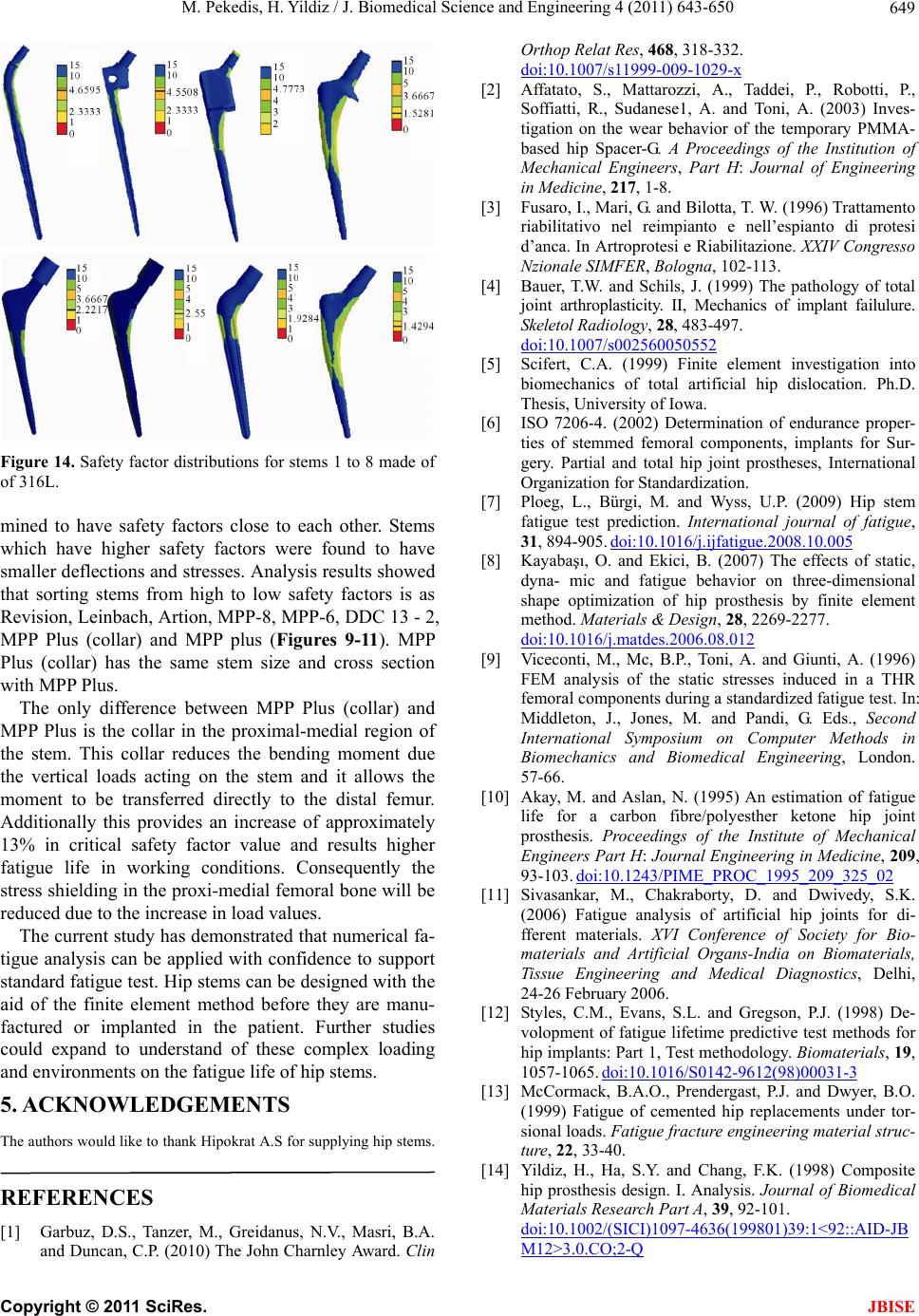
M. Pekedis, H. Yildiz / J. Biomedical Science and Engineering 4 (2011) 643-650 649
Figure 14. Safety factor distributions for stems 1 to 8 made of
of 316L.
mined to have safety factors close to each other. Stems
which have higher safety factors were found to have
smaller deflections and stresses. Analysis results showed
that sorting stems from high to low safety factors is as
Revision, Leinbach, Artion, MPP-8, MPP-6, DDC 13 - 2,
MPP Plus (collar) and MPP plus (Figures 9-11). MPP
Plus (collar) has the same stem size and cross section
with MPP Plus.
The only difference between MPP Plus (collar) and
MPP Plus is the collar in the proximal-medial region of
the stem. This collar reduces the bending moment due
the vertical loads acting on the stem and it allows the
moment to be transferred directly to the distal femur.
Additionally this provides an increase of approximately
13% in critical safety factor value and results higher
fatigue life in working conditions. Consequently the
stress shielding in the proxi-medial femoral bone will be
reduced due to the increase in load values.
The current study has demonstrated that numerical fa-
tigue analysis can be applied with confidence to support
standard fatigue test. Hip stems can be designed with the
aid of the finite element method before they are manu-
factured or implanted in the patient. Further studies
could expand to understand of these complex loading
and environments on the fatigue life of hip stems.
5. ACKNOWLEDGEMENTS
The authors would like to thank Hipokrat A.S for supplying hip stems.
REFERENCES
[1] Garbuz, D.S., Tanzer, M., Greidanus, N.V., Masri, B.A.
and Duncan, C.P. (2010) The John Charnley Award. Clin
Orthop Relat Res, 468, 318-332.
doi:10.1007/s11999-009-1029-x
[2] Affatato, S., Mattarozzi, A., Taddei, P., Robotti, P.,
Soffiatti, R., Sudanese1, A. and Toni, A. (2003) Inves-
tigation on the wear behavior of the temporary PMMA-
based hip Spacer-G. A Proceedings of the Institution of
Mechanical Engineers, Part H: Journal of Engineering
in Medici ne, 217, 1-8.
[3] Fusaro, I., Mari, G. and Bilotta, T. W. (1996) Trattamento
riabilitativo nel reimpianto e nell’espianto di protesi
d’anca. In Artroprotesi e Riabilitazione. XXIV Congresso
Nzionale SIMFER, Bologna, 102-113.
[4] Bauer, T.W. and Schils, J. (1999) The pathology of total
joint arthroplasticity. II, Mechanics of implant failulure.
Skeletol Radiology, 28, 483-497.
doi:10.1007/s002560050552
[5] Scifert, C.A. (1999) Finite element investigation into
biomechanics of total artificial hip dislocation. Ph.D.
Thesis, University of Iowa.
[6] ISO 7206-4. (2002) Determination of endurance proper-
ties of stemmed femoral components, implants for Sur-
gery. Partial and total hip joint prostheses, International
Organization for Standardization.
[7] Ploeg, L., Bürgi, M. and Wyss, U.P. (2009) Hip stem
fatigue test prediction. International journal of fatigue,
31, 894-905. doi:10.1016/j.ijfatigue.2008.10.005
[8] Kayabaşı, O. and Ekici, B. (2007) The effects of static,
dyna- mic and fatigue behavior on three-dimensional
shape optimization of hip prosthesis by finite element
method. Materials & Design, 28, 2269-2277.
doi:10.1016/j.matdes.2006.08.012
[9] Viceconti, M., Mc, B.P., Toni, A. and Giunti, A. (1996)
FEM analysis of the static stresses induced in a THR
femoral components during a standardized fatigue test. In:
Middleton, J., Jones, M. and Pandi, G. Eds., Second
International Symposium on Computer Methods in
Biomechanics and Biomedical Engineering, London.
57-66.
[10] Akay, M. and Aslan, N. (1995) An estimation of fatigue
life for a carbon fibre/polyesther ketone hip joint
prosthesis. Proceedings of the Institute of Mechanical
Engineers Part H: Journal Engineering in Medicine, 209,
93-103. doi:10.1243/PIME_PROC_1995_209_325_02
[11] Sivasankar, M., Chakraborty, D. and Dwivedy, S.K.
(2006) Fatigue analysis of artificial hip joints for di-
fferent materials. XVI Conference of Society for Bio-
materials and Artificial Organs-India on Biomaterials,
Tissue Engineering and Medical Diagnostics, Delhi,
24-26 February 2006.
[12] Styles, C.M., Evans, S.L. and Gregson, P.J. (1998) De-
volopment of fatigue lifetime predictive test methods for
hip implants: Part 1, Test methodology. Biomaterials, 19,
1057-1065. doi:10.1016/S0142-9612(98)00031-3
[13] McCormack, B.A.O., Prendergast, P.J. and Dwyer, B.O.
(1999) Fatigue of cemented hip replacements under tor-
sional loads. Fatigue fracture engineering material struc-
ture, 22, 33-40.
[14] Yildiz, H., Ha, S.Y. and Chang, F.K. (1998) Composite
hip prosthesis design. I. Analysis. Journal of Biomedical
Materials Research Part A, 39, 92-101.
doi:10.1002/(SICI)1097-4636(199801)39:1<92::AID-JB
M12>3.0.CO;2-Q
C
opyright © 2011 SciRes. JBISE